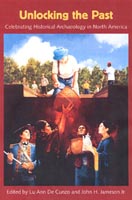Part 2: Challenging & Changing Environments: Exploring New Lands and Exploiting New Environments

Miners at work in the Argonaut Mine in Jackson, California
In the early modern era, explorers and settlers traveled to North America seeking both land and its resources. They took timber for ships and buildings, furs and hides for clothing, iron for tools and weapons, plants and animals for food, drink, and medicine, and gold and silver for their precious symbolism of wealth. Archaeology has a long history of studying how peoples use culture to adapt to, make sense of, give value to, and reshape their environments.
We bring a unique perspective to environmental history and cultural landscapes because we study the environment and cultural imprints on the land directly. Working with researchers from many disciplines, historical archaeologists have learned much about the constant give and take between people and land inscribed in soils, roads and fences, buildings and ditches, plants and animals. In this chapter, we follow past peoples on their expeditions to the Arctic, the coastal plains of the Southeast, the bays of the Mexican Gulf coast, and the mountains and deserts of the West.
In each place and at different times, these settlers adapted to hostile environments in numerous ways. In the inhospitable arctic, both the Norse in the eleventh century and the English mining expedition in the sixteenth century had to weigh the costs versus the gains of exploiting the frozen land. Early in the next century, the English found the warm, humid wetlands of tidewater Virginia barely more welcoming when they planted a colony on Jamestown Island. Still further south, La Salle sailed into the Gulf of Mexico near the century’s end seeking a passage through North America to the Orient and a favorable place for a French settlement. But the mudflats of the Texas Gulf coast proved hostile to these settlers unfamiliar with its foods and unprepared for its storms, insects and reptiles, and the diseases they carried. Almost two centuries later, for new immigrants mining the Sierra Nevadas to the north and west, the tools of industrialization offered little comfort in the isolation of winter.
The dynamic history of people and the land in North America has many complicated layers. In Jamestown, the National Park Service-sponsored team learned to follow the money and the goods, where they came from and how they were used, to unravel the economics of city-building in the early English colony. In the West, the scale of mining and the extent of the environmental consequences have led archaeologists to stories of poisoning and cleanups and, again, of money, this time on an industrial scale. But like the archaeologists excavating La Salle’s ship, La Belle, they also seek to tell stories of people. With their help, we can literally see the Irish miners and French colonists and learn how places like target-shooting galleries and objects like ancient Roman coins offered some small comfort against the uncertainties of sea voyages and immigration to an alien land.
For generations, many of us learned that the story of the Americas began with Christopher Columbus’ “discovery” in 1492. But that is only one place to begin the story. There are other, often less familiar but equally important, stories to tell about encounters between people and the unique and diverse environments of North America.
